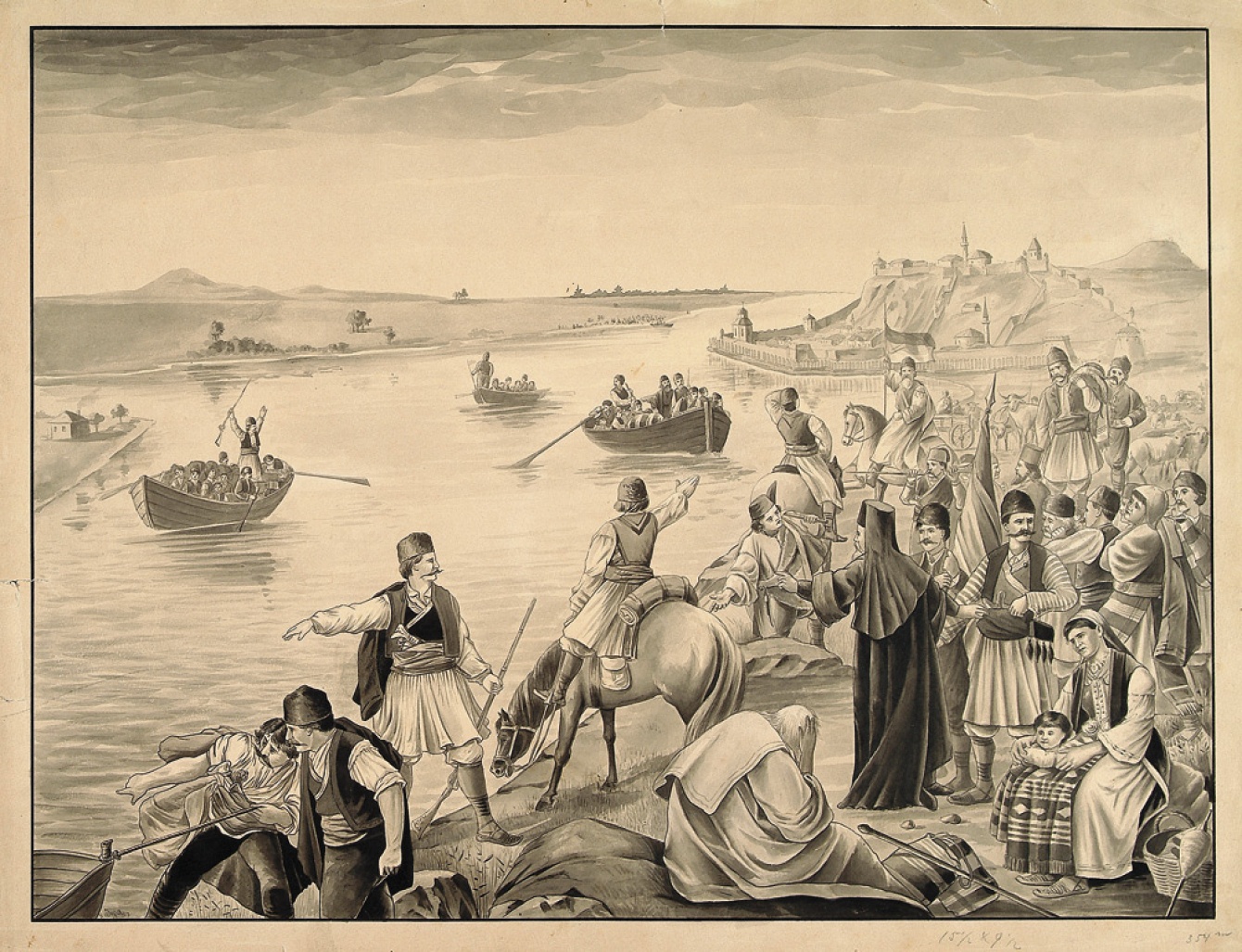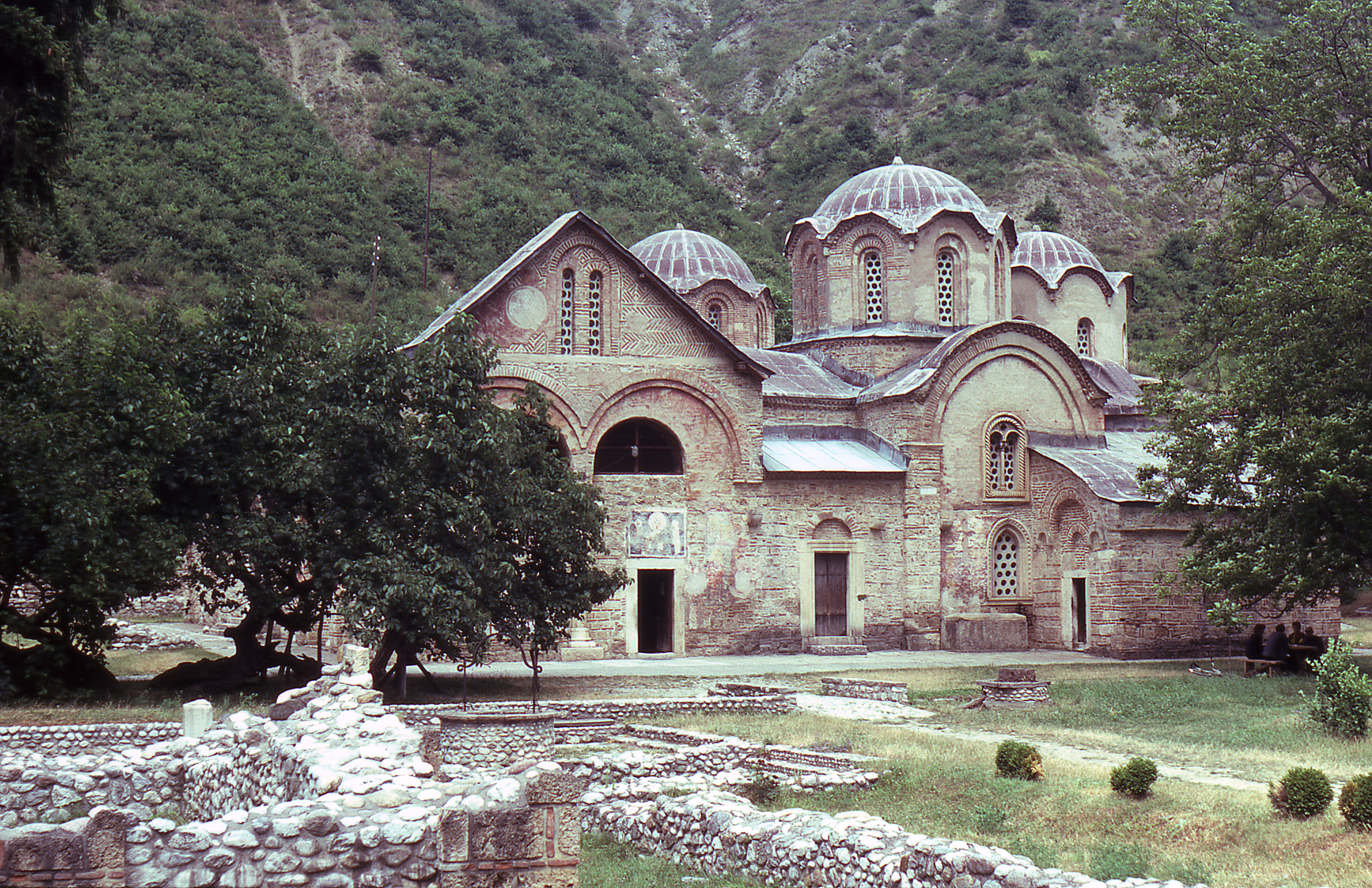|
Great Serb Migrations
The Great Migrations of the Serbs (), also known as the Great Exoduses of the Serbs, were two migrations of Serbs from various territories under the rule of the Ottoman Empire to the Kingdom of Hungary under the Habsburg monarchy. The First Great Migration occurred during the Habsburg-Ottoman War of 1683–1699 under Serbian Patriarch Arsenije III Crnojević as a result of the Habsburg retreat and the Ottoman reoccupation of southern Serbian regions, which were temporarily held by the Habsburgs between 1688 and 1690. The Second Great Migration took place during the Habsburg-Ottoman War of 1737–1739, under the Serbian Patriarch Arsenije IV Jovanović, also parallel with the Habsburg withdrawal from Serbian regions; between 1718 and 1739, these regions were known as the Kingdom of Serbia. The masses of earlier migrations from the Ottoman Empire are considered ethnically Serb, and those of the First Great Migration nationally Serb. The First Great Migration brought about ... [...More Info...] [...Related Items...] OR: [Wikipedia] [Google] [Baidu] |
Treaty Of Karlowitz
The Treaty of Karlowitz, concluding the Great Turkish War of 1683–1699, in which the Ottoman Empire was defeated by the Holy League at the Battle of Zenta, was signed in Karlowitz, in the Military Frontier of the Habsburg Monarchy (present-day Sremski Karlovci, Serbia), on 26 January 1699. Also known as "The Austrian treaty that saved Europe", it marks the end of Ottoman control in much of Central Europe, with their first major territorial losses in Europe, beginning the reversal of four centuries of expansion (1299–1683). The treaty established the Habsburg monarchy as the dominant power of the region. Context and terms Following a two-month congress between the Ottoman Empire on one side, and the Holy League of 1684– a coalition of the Holy Roman Empire, the Polish–Lithuanian Commonwealth, the Republic of Venice, and Peter the Great– the tsar of Russia, a peace treaty was signed on 26 January 1699. On the basis of ', the treaty confirmed the territorial holdings o ... [...More Info...] [...Related Items...] OR: [Wikipedia] [Google] [Baidu] |
Arsenije IV Jovanović Šakabenta
Arsenije IV Jovanović Šakabenta ( sr-cyr, Арсеније IV Јовановић Шакабента, ; 1698 – 18 January 1748) was the Archbishop of Peć and Serbian Patriarch from 1725 to 1737 and Head of the Serbian Orthodox Church in Habsburg Monarchy from 1737 to his death in 1748. He commissioned the Slavic heraldic bearings called '' Stemmatographia.'' He opened the first official Academy of Painting on the territory of the Metropolitanate of Karlovci after the artistic and cultural reforms were commenced under the auspices and blessing of Vikentije Jovanović, his predecessor. He was succeeded by Joannicius III of Constantinople. Biography Treaty of Belgrade With the 1739 Treaty of Belgrade which ended the Austro-Turkish War (1737–1739), the Kingdom of Serbia ceased to exist. The Ottoman sultan deposed the pro-Serbian Patriarch of Peć Arsenije IV and in his place appointed the Greek Joannicius, who took the title of ''Archbishop of Peć and Patriarch of t ... [...More Info...] [...Related Items...] OR: [Wikipedia] [Google] [Baidu] |
Great Serb Migration
The Great Migrations of the Serbs (), also known as the Great Exoduses of the Serbs, were two migrations of Serbs from various territories under the rule of the Ottoman Empire to the Kingdom of Hungary under the Habsburg monarchy. The First Great Migration occurred during the Habsburg-Ottoman War of 1683–1699 under Serbian Patriarch Arsenije III Crnojević as a result of the Habsburg retreat and the Ottoman reoccupation of southern Serbian regions, which were temporarily held by the Habsburgs between 1688 and 1690. The Second Great Migration took place during the Habsburg-Ottoman War of 1737–1739, under the Serbian Patriarch Arsenije IV Jovanović, also parallel with the Habsburg withdrawal from Serbian regions; between 1718 and 1739, these regions were known as the Kingdom of Serbia. The masses of earlier migrations from the Ottoman Empire are considered ethnically Serb, and those of the First Great Migration nationally Serb. The First Great Migration brought about ... [...More Info...] [...Related Items...] OR: [Wikipedia] [Google] [Baidu] |
Arsenije III
Arsenije ( sr-cyr, Арсеније; ) is a Serbian given name, a variant of the Greek name ''Arsenios''. Diminutives of the name include ''Arsen'', ''Arsa'' and '' Arso''. It may refer to: *Arsenije Sremac (died 1266), second Archbishop of the Serbian Orthodox Church (1233–1263) * Arsenije II, Archbishop of Peć and Serbian Patriarch from 1457 to 1463 *Arsenije III Čarnojević (1633–1706), Serbian Patriarch (1674–1706) *Arsenije IV Jovanović Šakabenta (1698–1748), Serbian Patriarch (1725–1748) *Arsenije Plamenac, Metropolitan of Cetinje (1781–1784) *Arsenije Sečujac (1720–1814), Habsburg general *Arsenije Loma (1778–1815), Serbian revolutionary * Arsenije Milošević (1931–2006), Yugoslav and Serbian film and television director *Arsenije Zlatanović Arsenije Zlatanović (; born 4 December 1989) is a Serbian inactive tennis player. Zlatanović has a career high Association of Tennis Professionals, ATP singles ranking of 609 achieved on 30 April 2012. He a ... [...More Info...] [...Related Items...] OR: [Wikipedia] [Google] [Baidu] |
Leopold I, Holy Roman Emperor
Leopold I (Leopold Ignaz Joseph Balthasar Franz Felician; ; 9 June 1640 – 5 May 1705) was Holy Roman Emperor, King of Hungary, List of Croatian monarchs, Croatia, and List of Bohemian monarchs, Bohemia. The second son of Ferdinand III, Holy Roman Emperor, by his first wife, Maria Anna of Spain, Leopold became heir apparent in 1654 after the death of his elder brother Ferdinand IV, King of the Romans, Ferdinand IV. Elected in 1658, Leopold ruled the Holy Roman Empire until his death in 1705, becoming the second longest-ruling emperor (46 years and 9 months) of the House of Habsburg. He was both a composer and considerable patron of music. Leopold's reign is known for conflicts with the Ottoman Empire in the Great Turkish War (1683–1699) and rivalry with Louis XIV, a contemporary and first cousin (on the maternal side; fourth cousin on the paternal side), in the west. After more than a decade of warfare, Leopold emerged victorious in the east thanks to the military talents of Pr ... [...More Info...] [...Related Items...] OR: [Wikipedia] [Google] [Baidu] |
List Of Serbian Historians
This is a list of Serbian historians, including area of expertise. * Čedomir Antić (born 1974), the modern history of Serbia * Lazar Arsenijević Batalaka (1793-1869), history of the Serbian revolution (1803-1813) * Dušan T. Bataković (1957–2017), the modern history of Serbia * Miloš Blagojević (1930–2012), medieval Serbia * Dimitrije Bogdanović (1930–1986), medieval Serbia and church history * Veselin Čajkanović (1881–1946), classical * Vladimir Ćorović (1885–1941), medieval Serbia and Bosnia * Sima Ćirković (1929–2009), medieval Serbia and Bosnia * Vladimir Dedijer (1914–1990), World War II * Ljubodrag Dimić (born 1956), history of Yugoslavia * Dimitrije Đorđević (1922–2009), modern Balkans *Milorad Ekmečić (1928–2015), the modern history of Serbia and Bosnia * Božidar Ferjančić (1929–1998), medieval Serbia and Byzantine Empire * Andra Gavrilović (1864–1929), literary history * Vojislav Korać (1924–2010), medieval architecture * Laz ... [...More Info...] [...Related Items...] OR: [Wikipedia] [Google] [Baidu] |
Joseph I, Holy Roman Emperor
Joseph I (Joseph Jacob Ignaz Johann Anton Eustachius; 26 July 1678 – 17 April 1711) was Holy Roman Emperor and ruler of the Habsburg monarchy from 1705 until his death in 1711. He was the eldest son of Leopold I, Holy Roman Emperor from his third wife, Eleonor Magdalene of Neuburg. Joseph was crowned King of Hungary at the age of nine in 1687 and was elected King of the Romans at the age of eleven in 1690. He succeeded to the thrones of Bohemia and the Holy Roman Empire when his father died. Joseph continued the War of the Spanish Succession, begun by his father against Louis XIV of France, in an attempt to make his younger brother Charles (later Emperor Charles VI) King of Spain. In the process, however, owing to the victories won by his military commander, Prince Eugene of Savoy, he did succeed in establishing Austrian hegemony over Italy. Joseph also had to contend with a protracted revolt in Hungary, fomented by Louis XIV. Neither conflict was resolved until the Treaty of Ut ... [...More Info...] [...Related Items...] OR: [Wikipedia] [Google] [Baidu] |
Pressburg
Bratislava (German: ''Pressburg'', Hungarian: ''Pozsony'') is the Capital city, capital and largest city of the Slovakia, Slovak Republic and the fourth largest of all List of cities and towns on the river Danube, cities on the river Danube. Officially, the population of the city is about 475,000; however, some sources estimate daily number of people moving around the city based on mobile phone SIM cards is more than 570,000. Bratislava is in southwestern Slovakia at the foot of the Little Carpathians, occupying both banks of the Danube and the left bank of the Morava (river), River Morava. Bordering Austria and Hungary, it is the only national capital to border two sovereign states. The city's history has been influenced by people of many nations and religions, including Austrians, Bulgarians, Croats, Czechs, Germans, Hungarian people, Hungarians, Jews and Slovaks. It was the coronation site and legislative center and capital of the Kingdom of Hungary from 1536 to 1783; elev ... [...More Info...] [...Related Items...] OR: [Wikipedia] [Google] [Baidu] |
Hungarian Diet
The Diet of Hungary or originally: Parlamentum Publicum / Parlamentum Generale () was the most important political assembly in Hungary since the 12th century, which emerged to the position of the supreme legislative institution in the Kingdom of Hungary from the 1290s, and in its successor states, Royal Hungary and the Habsburg kingdom of Hungary throughout the early modern period until the end of World War II. The name of the legislative body was originally "Parlamentum" during the Middle Ages, the "Diet" expression gained mostly in the early modern period. It convened at regular intervals with interruptions from the 12th century to 1918, and again until 1946. The articles of the 1790 diet set out that the diet should meet at least once every 3 years, but since the diet was called by the Habsburg monarchy, this promise was not kept on several occasions thereafter. As a result of the Austro-Hungarian Compromise, it was reconstituted in 1867. The Latin term ''Natio Hungarica ... [...More Info...] [...Related Items...] OR: [Wikipedia] [Google] [Baidu] |
Serbian Patriarchate Of Peć
Serbian Patriarchate of Peć (, ''Srpska patrijaršija u Peći''), or simply Peć Patriarchate (, ''Pećka patrijaršija''), was an autocephaly, autocephalous Eastern Orthodox Patriarchate that existed from 1346 to 1463, and then again from 1557 to 1766 with its seat in the Patriarchal Monastery of Peć. It had ecclesiastical jurisdiction over Eastern Orthodox Christians in Serbian Lands and other western regions of Southeastern Europe. Primates of the Patriarchate were styled ''Archbishop of Peć and Serbian Patriarch''. Medieval Period (1346–1463) Since 1219, the Eastern Orthodox Church in the medieval Kingdom of Serbia (medieval), Kingdom of Serbia was organized as an autocephaly, autocephalous Archbishopric seated at first in the Monastery of Žiča and since the middle of the 13th century in the Patriarchal Monastery of Peć, Monastery of Peć. Political expansion of the Serbian medieval state culminated under the reign of King Stefan Dušan (1331–1355), who conquere ... [...More Info...] [...Related Items...] OR: [Wikipedia] [Google] [Baidu] |







